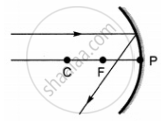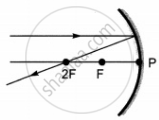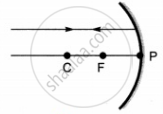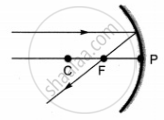Advertisements
Advertisements
Question
The diagram shows a dish antenna which is used to receive television signals from a satellite. The antenna (signal detector) is fixed in front of the curved dish.
Figure
(a) What is the purpose of the dish?
(b) Should it be concave or convex?
(c) Where should the antenna be positioned to receive the strongest possible signals?
(d) Explain what change you would expect in the signals if a larger dish was used.
Solution
(b) The dish should be concave.
(c) The antenna should be positioned at the focus of the concave dish to receive the strongest possible signals.
(d) If a larger dish was used, the aperture of the concave mirror would have been bigger; therefore, the signals received by the antenna would have been stronger.
APPEARS IN
RELATED QUESTIONS
Consider the following diagram in which M is a mirror and P is an object and Q is its magnified image formed by the mirror.

State the type of the mirror M and one characteristic property of the image Q.
A spherical mirror produces an image of magnification -1.0 on a screen placed at a distance of 30 cm from the pole of the mirror.
(i) Write the type of mirror in this case.
(ii) What is the focal length of the mirror ?
(iii) What is the nature of the image formed ?
(iv) Draw the ray diagram to show the image formation in this case.
The image formed by a concave mirror is observed to be virtual, erect and larger than the object. Where should be the position of the object?
Make labelled ray diagrams to illustrate the formation of:
a virtual image by a converging mirror.
Mark clearly the pole, focus, centre of curvature and position of object in each case.
What would your image look like if you stood close to a large:
concave mirror?
A student has focused the image of a candle flame on a white screen using a concave mirror. The situation is as given below:
Length of the flame = 1.5 cm
Distance of flame from the mirror = 18 cm
If the flame is perpendicular to the principal axis of the mirror, then calculate the following:
- Distance of the image from the mirror
- Length of the image
If the distance between the mirror and the flame is reduced to 10 cm, then what would be observed on the screen? Draw ray diagram to justify your answer for this situation.
Rays from Sun converge at a point 15 cm in front of a concave mirror. Where should an object be placed so that size of its image is equal to the size of the object?
Which of the following ray diagrams is correct for the ray of light incident on a concave mirror as shown in figure?

 |
 |
 |
 |
| A | B | C | D |
You are provided with a convex mirror, a concave mirror, a convex lens and a concave lens. You can get an inverted image from
In torches, searchlights, and headlights of vehicles, the bulb is placed ______ of the concave mirror.
